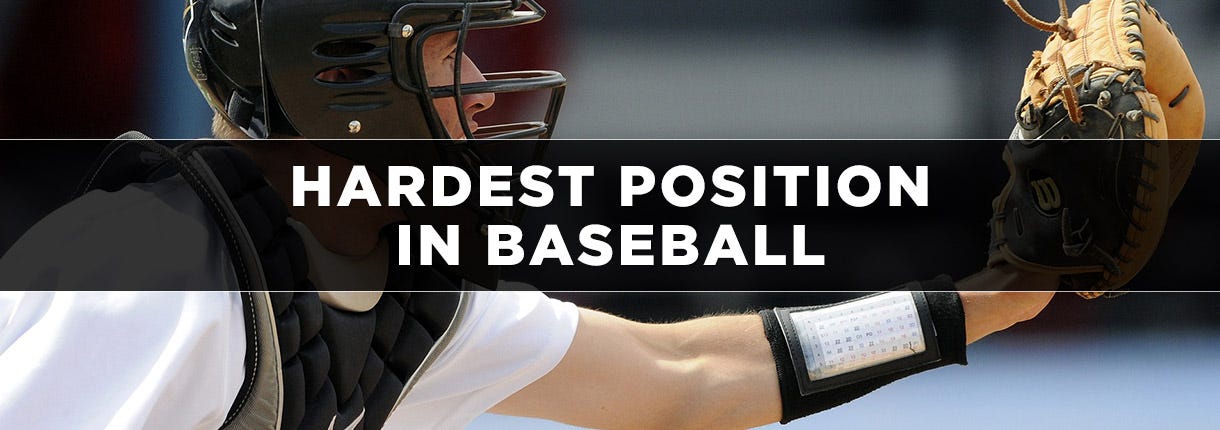Hardest Position in Baseball Explained - Find Out Now!

Baseball has nine defensive positions, each requiring a unique skill set. The pitcher controls the game with strategic pitching, while the catcher manages the defense, blocking pitches and calling plays. Infielders—first baseman, second baseman, shortstop, and third baseman—handle ground balls and turn double plays, with shortstop often considered the most athletic. Outfielders—left, center, and right fielders—cover large areas, with center fielders needing elite speed and right fielders possessing the strongest arms. While all positions have challenges, some demand greater physical endurance, mental toughness, or leadership, making them candidates for the hardest position in baseball.
In this article, we'll cover:
Hardest Baseball Positions: Know the Factors
Factors That Contribute to the Difficulty of Baseball Positions
- Physical Demands
- Catchers endure constant squatting, blocking pitches, and absorbing foul tips.
- Pitchers require arm endurance, precision, and the ability to throw with velocity and movement.
- Shortstops and center fielders need elite agility, speed, and range to cover large areas.
- Mental Resilience
- Pitchers must handle pressure, adjust strategy against hitters, and maintain focus for every pitch.
- Catchers call the game, control the pace, and manage the pitching staff.
- Infielders and outfielders must react instantly to unpredictable plays while staying mentally engaged.
- Tactical Understanding
- Catchers must read batters, coordinate defensive alignments, and control the running game.
- Middle infielders (shortstop and second base) need quick decision-making for double plays and cutoffs.
- Outfielders, especially in center field, must judge fly balls accurately and communicate with teammates.
Each position presents unique challenges, but some demand a greater combination of physical endurance, mental toughness, and game awareness, making them contenders for the hardest position in baseball.
What is the Hardest Position in Baseball?
Unique Challenges of the Catcher Position
- Physical Demands: Constant squatting, blocking pitches, absorbing foul tips, and making quick throws to bases.
- Mental Demands: Calls pitches, manages the game flow, controls the running game, and maintains focus for all nine innings.
- Key Skills: Quick reflexes, endurance, leadership, and strong game awareness.
The Shortstop: Agility and Decision-Making
- Physical Demands: Covers the most ground in the infield, requires quick footwork, strong arm strength, and elite agility.
- Mental Demands: Must anticipate plays, coordinate with infielders, and react instantly to fast-moving ground balls.
- Key Skills: Athleticism, quick decision-making, defensive awareness, and strong throwing accuracy.
Pitching: Endurance and Precision
- Physical Demands: High-intensity throwing, endurance to last multiple innings, and the ability to generate velocity and movement.
- Mental Demands: Must read hitters, adjust pitch selection, handle pressure situations, and recover from mistakes quickly.
- Key Skills: Precision, composure, adaptability, and stamina
Baseball Positions Ranked by Difficulty
| Rank | Position | Physical Demands | Metal Acuity & Strategy | Key Challenges |
| 1 | Catcher | Constant squatting, blocking, quick throws | Calls pitches, manages pitchers, controls game flow | Endurance, leadership, reaction time |
| 2 | Pitcher | High-stress throwing, arm endurance | Reads hitters, adjusts strategy, handles pressure | Precision, mental toughness, stamina |
| 3 | Shortstop | Quick footwork, strong arm, agility | Anticipates plays, coordinates infield | Range, fast decision-making, strong throws |
| 4 | Center Fielder | Covers most ground, speed, strong arm | Reads fly balls, controls outfield defense | Reaction time, communication, athleticism |
| 5 | Third Baseman | Quick reflexes, strong arm, lateral movement | Reacts to hard-hit balls, makes quick decisions | “Hot corner” pressure, throwing accuracy |
| 6 | Second Baseman | Quick hands, agility, pivoting for double plays | Reads ground balls, turns double plays | Footwork, defensive coordination |
| 7 | Right Fielder | Strongest outfield arm, decent speed | Judges deep fly balls, prevent extra bases | Long throws, reaction to line drives |
| 8 | Left Fielder | Less ground to cover, and a strong but not elite arm | Reads hits, backs up plays | Fielding consistency, supporting defense |
| 9 | First Baseman | Frequent catching, limited movement | Handles tough throws, starts double plays | Stretching ability, quick reactions |
Hardest Position in Baseball FAQs
What is the universally agreed-upon hardest position in baseball?
- Catcher is widely considered the toughest position due to its intense physical strain, game management responsibilities, and leadership role. Pitchers and shortstop are also highly demanding because of their need for precision, endurance, and quick decision-making.
How do players train for the most demanding baseball positions?
- Catchers focus on leg strength, reaction drills, and pitch framing, while pitchers train arm mechanics, endurance, and mental toughness. Shortstops work on quick footwork, fielding instincts, and throwing accuracy through infield drills.
Are there specific personality traits that benefit certain positions over others?
- Catchers need leadership and resilience, pitchers benefit from composure and focus, and shortstops thrive with quick thinking and confidence. Outfielders require patience, anticipation, and fearlessness when tracking fly balls.
How have perceptions of the hardest position changed over time?
- Catcher has traditionally been seen as the hardest position, but advancements in analytics and training have highlighted the mental and physical demands of pitching. Defensive shifts and evolving strategies have also increased the challenges faced by shortstops and center fielders.








